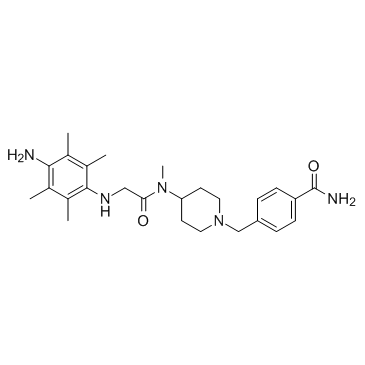All AbMole products are for research use only, cannot be used for human consumption.

In vitro: SUN11602 prevents glutamate-induced neuronal death in primary cultures of rat cerebrocortical neurons. SUN11602 increases the levels of CALB1 gene expression in cerebrocortical neurons. SUN11602 exerts protective effects on hippocampal neurons through activation of FGFR1 and increases CalB expression. SUN11602 promotes neurite outgrowth of primarily cultured rat hippocampal neurons.
In vivo: In WT mice, SUN11602 increases the levels of newly synthesized Calb in cerebrocortical neurons and suppresses the glutamate-induced rise in intracellular Ca2+. This Ca2+-capturing ability of Calb allows the neurons to survive severe toxic conditions of glutamate. Oral administration of SUN11602 at the midpoint of Aβ1-40 and ibotenate injections attenuate short-term memory impairment in the Y-maze test, as well as spatial learning deficits in the water maze task. In addition, the SUN11602 treatment inhibits the increase of peripheral-type benzodiazepine-binding sites (PTBBS),which are a marker for gliosis.
| Cell Experiment | |
|---|---|
| Cell lines | hippocampal neurons |
| Preparation method | Cerebrocortical neurons are pretreated with vehicle (Hanks’ Balanced Salt Solution), SUN11602, bFGF, or the other growth factors for 24 h prior to the onset of glutamate toxicity. Subsequently, 10 μL of the MTT solution (5 mg/mL) is added to each well (200 μL of culture medium) of the microplates. Neurons in each well are then dried for 24 h, and 200 μL of DMSO is poured into all of the wells in order to dissolve the reaction products thoroughly for the MTT assay |
| Concentrations | 10 μM |
| Incubation time | 24 h |
| Animal Experiment | |
|---|---|
| Animal models | F344/DuCrj rats |
| Formulation | |
| Dosages | 0.1, 1, and 10 mg/kg |
| Administration | orally |
| Molecular Weight | 451.6 |
| Formula | C26H37N5O2 |
| CAS Number | 704869-38-5 |
| Solubility (25°C) | 37 mg/mL in DMSO |
| Storage |
Powder -20°C 3 years ; 4°C 2 years In solvent -80°C 6 months ; -20°C 1 month |
| Related VEGFR/PDGFR Products |
|---|
| SU5208
SU5208 inhibits vascular endothelial growth factor receptor-2 (VEGFR2). |
| VEGFR-IN-1
VEGFR-IN-1 is a potent angiogenesis inhibitor with IC50s of 0.02, 0.18, 0.24 7.3, and 7 µM for KDR, Flt-1, c-Kit, EGF-R, and c-Src, respectively. |
| (Z)-Orantinib
(Z)-Orantinib ((Z)-SU6668) is a potent, selective, orally active and ATP competitive inhibitor of Flk‐1/KDR, PDGFRβ, and FGFR1, with IC50s of 2.1, 0.008, and 1.2 µM, respectively. |
| (Rac)-SAR131675
(Rac)-SAR131675 is the racemate of SAR131675. |
| AGL 2043
AGL 2043 is an effective inhibitor of PDGFR (IC50=0.8 μM) and TEL-PDGFR kinases, as well as FLT3 and KIT kinases. |
All AbMole products are for research use only, cannot be used for human consumption or veterinary use. We do not provide products or services to individuals. Please comply with the intended use and do not use AbMole products for any other purpose.


Products are for research use only. Not for human use. We do not sell to patients.
© Copyright 2010-2024 AbMole BioScience. All Rights Reserved.
